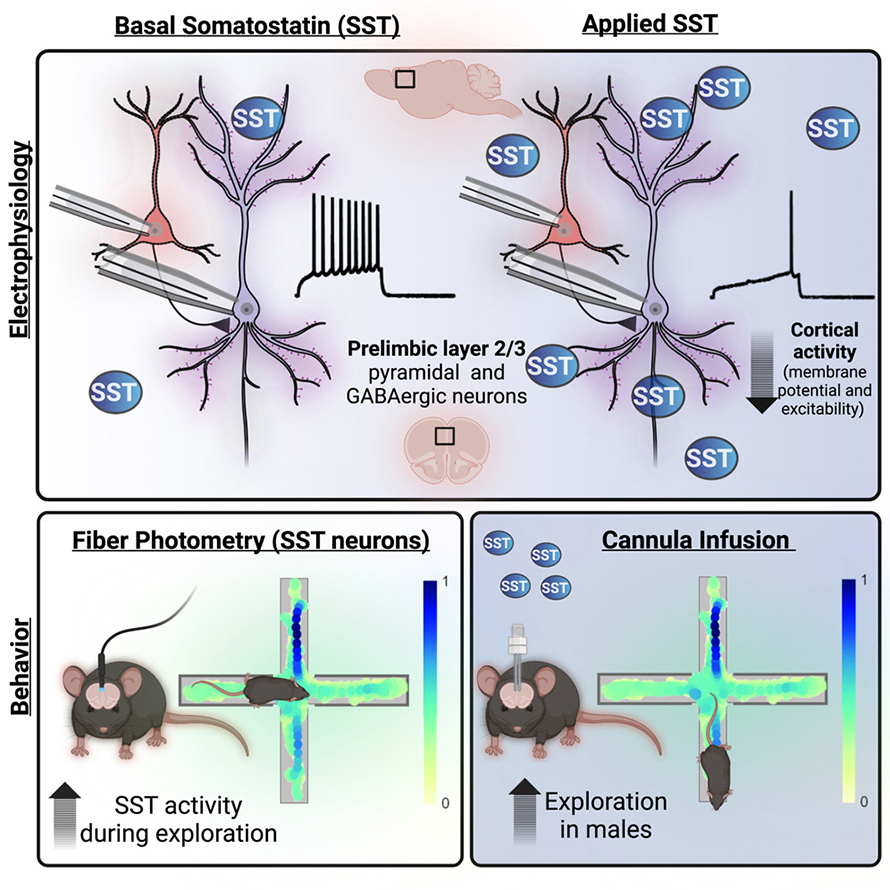Uncovering the role of somatostatin signaling in the brain
Somatostatin, a signaling molecule produced by many inhibitory neurons in the brain, broadly dampens communication among a variety of cell types in the prefrontal cortex and promotes exploratory and risk-taking-like behavior in mice, according to a Penn State-led research team. Their new paper, published today (Aug. 17) in the journal Cell Reports, describes the signaling mechanism of somatostatin in the prefrontal cortex, a brain region thought to be essential for executive functions like planning, memory, decision making and social behavior.
The research is an early step in deciphering somatostatin’s function in the human brain and how its signaling may go awry with several neuropsychiatric disorders, according to the researchers.

“Somatostatin has been heavily implicated in a number of different neuropsychiatric disorders,” said Nikki Crowley, Huck Early Career Chair in Neurobiology and Neural Engineering, assistant professor of biology in the Eberly College of Science and of biomedical engineering in the College of Engineering at Penn State, and the leader of the research team. “It is clinically implicated in individuals with conditions such as depression, schizophrenia, bipolar disorder, and cognitive decline, as well as alcohol drinking, but also general processes such as fear learning and avoidance behavior, but we don’t really know why. So, we set out to characterize its function in the prefrontal cortex of mice with the ultimate goal of finding ways to therapeutically target it to improve human health.”
Somatostatin is a neuropeptide, which is a small protein released by inhibitory neurons as a chemical messenger. Once released, it works by binding to receptor molecules expressed on other neurons, and potentially other cell types in the brain, which sets off a cascade of molecular changes in the cell. Neuropeptide signaling complements the signaling of classic neurotransmitters, like GABA, which is typically co-expressed in somatostatin neurons, and others such as dopamine and serotonin. The two types of signaling molecules use different pathways to communicate between cells and are released through different stimulation scenarios.
“The activity of neuropeptides can be much more difficult to measure,” Crowley said. “Signaling in the brain heavily relies on electrical communication. That is what is happening when we talk about the ‘firing’ of neurons. Neurotransmitters generally work through a combination of receptors, some of which allow electrical current to move in and out of neurons. We can measure this electrical activity relatively easily and have done so for over 50 years — but neuropeptide signaling does not directly produce an electrical signal. Only in more recent years have we had really good tools that allowed us to measure neuropeptide activity to begin to understand what they are doing.”

Activity of pyramidal neurons in the prefrontal cortex before (left) and after (right) application of somatostatin. Inhibitory neurons (pink) release somatostatin, a neuropeptide, that binds to receptors on the surface of pyramidal neurons (purple) and other cells in the brain. Representative traces from whole-cell current clamp recordings (black lines) show that the activity of pyramidal cells is reduced following both bath applied somatostatin, and light-evoked somatostatin release. Credit: Crowley Laboratory / Penn State. Creative Commons
The research team first characterized the effect that somatostatin signaling has on neurons within the prefrontal cortex. They measured the activity of these pyramidal neurons before and after artificially introducing the neuropeptide. They did this by directly applying a solution that contained somatostatin and, separately, by driving release of the neuropeptide through light-activation of somatostatin-releasing neurons. In both cases, the researchers saw the activity of the pyramidal neurons dampened.
“Somatostatin appears to function like a car’s brake, slowing the activity of neural circuitry in specific brain regions,” Crowley said. “We then wanted to know if this had a behavioral consequence.”
The researchers first tested if the somatostatin-releasing neurons were activated in two exploratory behavioral tests in mice. In one test, mice are placed on an elevated maze where they can choose to explore riskier, open arms of the maze that don’t have side walls or stick to safer arms with walls. In the second “open-field” test, mice can explore the center of an open field — simulating how mice might naturally be exposed to dangers — or stay in the relative safety of the edges.
“We saw that somatostatin neurons were most active just before entering the open arms of the maze or the center of the open field and while they explored these ‘riskier’ areas,” Crowley said. “This suggests that these neurons are involved in the decision to take risks.”
Next, the researchers artificially increased or decreased somatostatin signaling in the brains of mice and measured their behavior in these same mazes. Interestingly, Crowley noted, when somatostatin activity was increased, male mice showed increased exploratory, risk-taking behavior, but female mice did not. When the signaling was decreased, there was no significant change in behavior.
“The difference in behavior between males and females in exploratory behavior after we artificially increased somatostatin signaling is fascinating and something that we plan to explore in further research,” Crowley said. “Peptides can interact with many things, including potentially other hormones, and we’re looking at this now.”
Based on their experiments, the researchers suggest that somatostatin is fine-tuning the circuits in the prefrontal cortex to promote certain behaviors — specifically risk-taking, exploration, and decision making — over others.
“We know that this region of the brain drives higher-order behaviors and decision making in humans as well, and that somatostatin is related to several human neuropsychiatric disorders,” Crowley said. “As we continue to explore the function of somatostatin, we hope a better understanding of its role will help drive the development of new ways to treat these diseases where its expression might be reduced.”
This article was reprinted with permission from Penn State. Read the original.
Enjoy reading ASBMB Today?
Become a member to receive the print edition four times a year and the digital edition monthly.
Learn moreGet the latest from ASBMB Today
Enter your email address, and we’ll send you a weekly email with recent articles, interviews and more.
Latest in Science
Science highlights or most popular articles

Building the blueprint to block HIV
Wesley Sundquist will present his work on the HIV capsid and revolutionary drug, Lenacapavir, at the ASBMB Annual Meeting, March 7–10, in Maryland.

Gut microbes hijack cancer pathway in high-fat diets
Researchers at the Feinstein Institutes for Medical Research found that a high-fat diet increases ammonia-producing bacteria in the gut microbiome of mice, which in turn disrupts TGF-β signaling and promotes colorectal cancer.

Mapping fentanyl’s cellular footprint
Using a new imaging method, researchers at State University of New York at Buffalo traced fentanyl’s effects inside brain immune cells, revealing how the drug alters lipid droplets, pointing to new paths for addiction diagnostics.

Designing life’s building blocks with AI
Tanja Kortemme, a professor at the University of California, San Francisco, will discuss her research using computational biology to engineer proteins at the 2026 ASBMB Annual Meeting.

Cholesterol as a novel biomarker for Fragile X syndrome
Researchers in Quebec identified lower levels of a brain cholesterol metabolite, 24-hydroxycholesterol, in patients with fragile X syndrome, a finding that could provide a simple blood-based biomarker for understanding and managing the condition.

How lipid metabolism shapes sperm development
Researchers at Hokkaido University identify the enzyme behind a key lipid in sperm development. The findings reveal how seminolipids shape sperm formation and may inform future diagnostics and treatments for male infertility.

